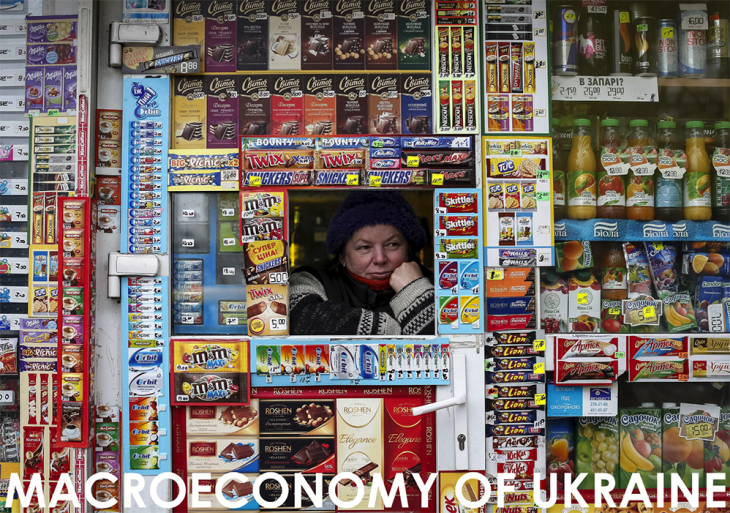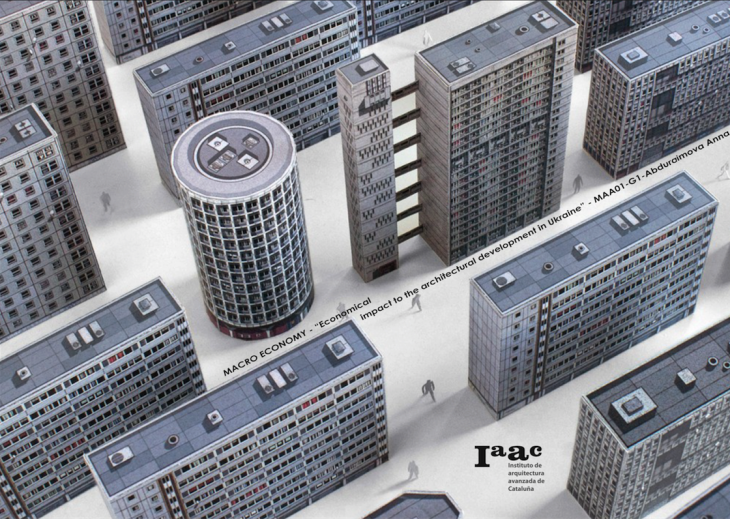
The territory of modern Ukraine has been inhabited since 32,000 BC.
During the Middle Ages, the area was a key centre of East Slavic culture, with the powerful state of Kievan Rus’ forming the basis of Ukrainian identity. Two brief periods of independence occurred during the 20th century, once near the end of World War I and another during World War II, but both occasions would ultimately see Ukraine’s territories conquered and consolidated into a Soviet republic, a situation that persisted until 1991, when Ukraine gained its independence from the Soviet Union in the aftermath of its dissolution at the end of the Cold War.

MIDDLE CENTURY ARCHITECTURE IN UKRAINE
Following independence, Ukraine declared itself a neutral state. but nonetheless formed a limited military partnership with the Russian Federation, other CIS countries and a partnership with NATO since 1994. In the 2000s, the government began leaning towards NATO, and a deeper cooperation with the alliance was set by the NATO-Ukraine Action Plan signed in 2002. It was later agreed that the question of joining NATO should be answered by a national referendum at some point in the future. Former President Viktor Yanukovych considered the current level of co-operation between Ukraine and NATO sufficient, and was against Ukraine joining NATO. In 2013, protests against the government of President Yanukovych broke out in downtown Kiev after the government made the decision to suspend the Ukraine-European Union Association Agreement and seek closer economic ties with Russia. This began a several months long wave of demonstrations and protests known as the Euromaidan, which later escalated into the 2014 Ukrainian revolution that ultimately resulted in the overthrowing of Yanukovych and the establishment of a new government. These events precipitated the Annexation of Crimea by the Russian Federation in February 2014, and the War in Donbass in March 2014; both are still ongoing as of December 2015. On January 1, 2016, Ukraine will join the Deep and Comprehensive Free Trade Area with the European Union.
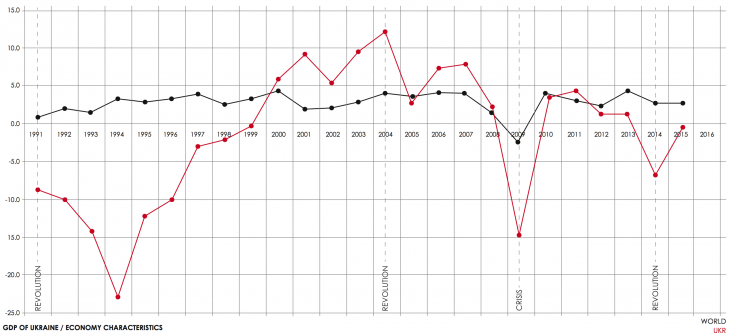
There’s a shirt review about main big projects made in particular time in Kiev.


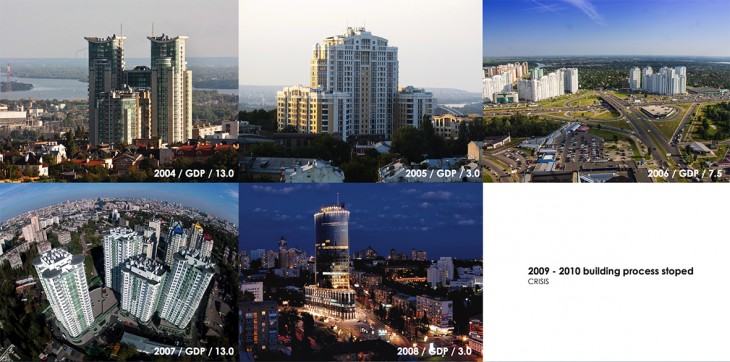

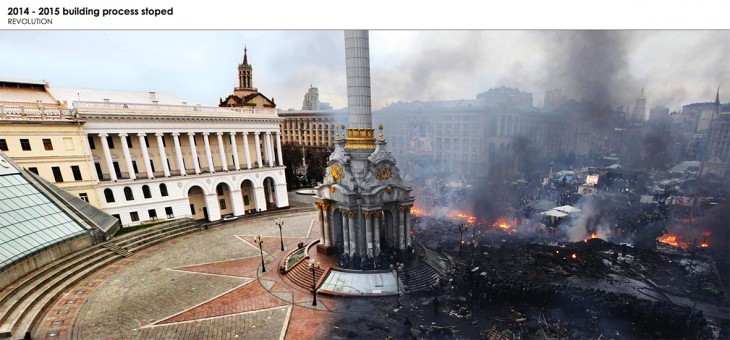
The economy of Ukraine is an emerging free market, with a gross domestic product that fell sharply for the first 10 years of its independence from the Soviet Union, then experienced rapid growth from 2000 until 2008. A deep recession during the 1990s included hyperinflation and a fall in economic output to less than half of that achieved before independence. GDP growth was first registered in 2000, and continued for eight years. In 2008, Ukraine’s economy was ranked 45th in the world according to 2008 GDP (nominal) with the total nominal GDP of 188 billion USD, and nominal per capita GDP of 3,900 USD. However Ukraine was greatly affected by the economic crisis of 2008. The Ukrainian currency, which had been pegged at a rate of 5:1 to the U.S. dollar, was deval- ued to 8:1, and was stabilized at that ratio till beginning of 2014, in the period of next year it was devaluated to 28:1. There was 3% unemployment at the end of 2008; over the first 9 months of 2009, unemployment averaged 9.4%. The final official unemployment rates over 2009 and 2010 where 8.8% and 8,4%. Although the CIA World Factbook notes a “large number of unregistered or underemployed workers”. The Ukrainian economy recovered in the first quarter of 2010.[13] Ukraine’s real GDP growth in 2010 was 4.3%, leading to per capita PPP GDP of 6,700 USD. As of 2013, 35.9% of Ukrainian exports went to CIS countries, namely Russia, Belarus and Kazakhstan. At same time share of EU countries was 26.6%. By 2015 the EU became Ukraine’s largest trading partner, accounting for more than a third of its trade. Natural gas is Ukraine’s biggest import and the main cause of the country’s structural trade deficit. Ukrainian politicians have estimated that 40% of the country’s economy is shadow economy. Due to the War in Donbass Ukraine’s economy shrank by 6.8% in 2014; it had been expected to decline by 8%. For 2015 a further decline of 9% is expected. Ukraine is relatively rich in natural resources, particularly in mineral deposits. Although oil and natural gas reserves in the country are largely exhausted, it has other important energy sources, such as coal, hydroelectricity and nuclear fuel raw materials.

In this small rewiev of Kiev architecture developing, related to GDP value per year, we can easely recognise that all big architecture of city absolutley depends of GDP value, which is changed because of politician situation in Ukraine, related to what happed in the world.
Architecture is built tin the city because of money income or outcome.
But what about social part of our city?
We don’t have a middle class (3-4 %), all people lives poor, takes money in credit, for buying expensive flats.
Related to all what we have seen in this arcitle it’s not so difficult to make a conclusion that:
There is a big distance between rich and poor class, rich people can build such an expensive huge buildings, in the same time, when social part takes a big credits from banks, to find that opportunity to buy a flat.
This poor – class, called – middle class takes 95% of all people in country.
Middle sallery is about 150$ per mounth.
That’s why we can see here are lots of “small architecture” construction for selling goods, it calls “??????”, this is one of the small amound of opportunity, of what people have, and how they can earm money.
Because taxes are high (30%), and everybody pressed to work inlegal to have at least any money.
And when people in country are soo poor, how could they think about cultural part.
They are poor and hungry, they need to sutisfy this basic needs before thinking about culture.
People doesn’t even think about what architecture of our country is our environment. And this environment has a huge impact to young generation, who see all this small ugly shops, and zirro cultural developing.
All what we can see, what is built in the city, all this surrounding make a huge impact to each people communicating with this environment, that the input which create us every day.
We have to strongly think about that, because could happen that this macro problems will begin to be uncontroleed, starting to destroy all beauty of our countries.
What is the architecture of our lifes of our minds?
